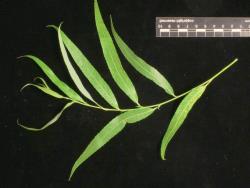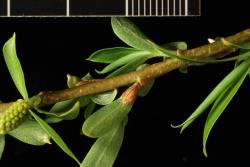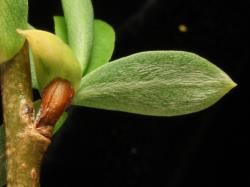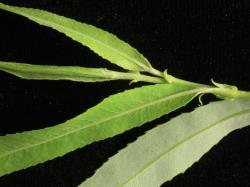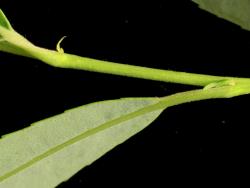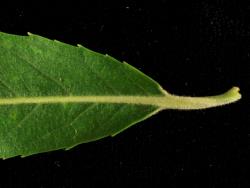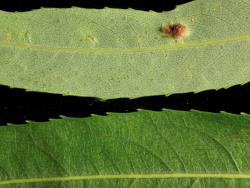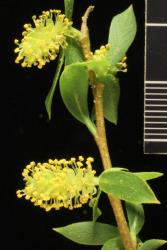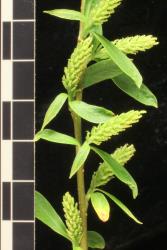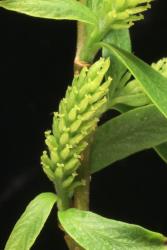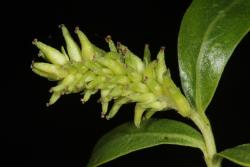Plants excluding 'Tortuosa'
Trees to 18 m with erect form, branchlets somewhat pendulous. Current year's branchlets glabrous to densely velvety, 1.4–1.7 mm diameter. Year-old branchlets very variable in colour: greyish yellow, moderate yellowish brown, dark orange-yellow, olive-green, or red-brown (UCL43), glabrous. Bud scales 4.2–5.4 mm long, 1.5–2 mm wide, orange (UCL53) to dark reddish orange (UCL38), glabrous. Stipule 2.5–11 mm long, very narrowly and asymmetrically ovate, not persisting. Petiole 5–17 mm long, densely tomentose on adaxial surface or on all surfaces, adaxial groove absent, glands absent. Emerging leaves green, with sparsely long-silky and short-silky hairs. Proximal leaves entire or toothed. Leaf lamina 90–150 mm long, 11–27 mm wide, length to width ratio 4.3–8.7:1, narrowly ovate to very narrowly ovate, falcate or not falcate; base cuneate; apex very narrowly acute; leaf galls abundant; orange rust commonly very abundant in late summer; margins moderately densely serrulate, flat; upper lamina surface smooth, midvein and side-veins raised, surface medium glossy, glabrous, stomata sparse and near midvein only; lower lamina surface midvein raised, slightly glaucous, very sparsely long-silky hairs present near midvein. Catkin emergence coetaneous with leaves. Flowering branch 10–26 mm long, with 3–5 reduced leaves. Male catkin 8–22 mm long, 5–6 mm diameter; catkin rachis visible between flowers. Female catkin 7–18 mm long, 3.5–4.5 mm diameter; catkin rachis not visible between flowers. Flower bract 1.0–2.4 mm long, 0.7–1.0 mm wide, pale yellow-green to pale green, channelled, curved inwards on long axis; apex acute to rounded, hairs sparse on base and lower margins only, not deciduous in female flowers. Male nectaries 2, 0.3–0.6 mm long, 0.32–0.36 mm wide, yellow. Stamens 2, filaments free, filament hairs absent; anthers 0.4–0.8 mm long, yellow. Female nectaries 1, 0.5–0.6 mm long, 0.34–0.6 mm wide, yellow; ovary 1.4–2.1 mm long, glabrous, sessile; style arms attached directly to ovary, very slightly 2-lobed, pale yellow to yellow-green to green.
Tree to 18 m. Branches erect-spreading or pendulous, branches and branchlets contorted or not. Leaves are glaucous below, with hairs on the lower surface when young. Leaf margin glandular-serrulate. Leaves may have abundant galls, and the species is particularly susceptible to an orange leaf rust in late summer. Male and female plants are present in New Zealand. Male and female catkins are short (18–22 mm long).
Similar to Salix ×pendulina and S. matsudana × S. alba and to Salix alba. Female catkins are shorter (8–22 mm long) than S. ×fragilis (43–63 mm), S. ×pendulina (17–38 mm), S. alba (23–39 mm), and S. matsudana × S. alba (20–27 mm). The style at the top of the ovary in S. matsudana × S. alba is about 0.4 mm long while in S. matsudana there is no unbranched section of style. While in the hybrid the style arms are deeply lobed, they are only slightly lobed in S. matsudana.
In cultivation in Auckland (Kumeū), Volcanic Plateau (Rotorua, Tauranga), and Southern North Island (Palmerston North).
The non-tortured form is known only in cultivation, however the biostatus of the species is recorded as exotic, fully naturalised, because S. matsudana is present in the wild as the cultivar 'Tortuosa'.
First collection: W. R. Sykes, 1 October 1980, Palmerston North, Esplanade Gardens, 16 m tree, stock from Eastwood Hill Arboretum, CHR 369291.
First publication: Hathaway (1986, p. 150).
Flowering: Early September–late September.
Provisionally tetraploid (result from flow cytometry using PN227).
Opinions are divided among willow taxonomists over whether to recognise Salix matsudana as a species distinct from S. babylonica. Koidzumi (1915) made no mention of S. babylonica and may have been unaware of the Chinese origin of that species when he described S. matsudana. Skvortsov (1999b) regarded S. matsudana as a synonym of S. babylonica. Fang et al. (1999) recognised S. babylonica and S. matsudana as two species and recognised three varieties within S. matsudana. They described S. matsudana as lacking the pendulous branches of S. babylonica. Argus (2010) recognised S. matsudana. Santamour & McArdle (1988) regarded S. matsudana as a synonym of S. babylonica, as did Chmelar (1983). Marchenko (2019) believed that S. matsudana should be a variety of S. babylonica, and that there should be formas within S. babylonica var. matsudana, one of those being f. tortuosa. This treatment follows Fang et al. (1999) and Argus (2010) in the recognition of S. matsudana at species rank.



